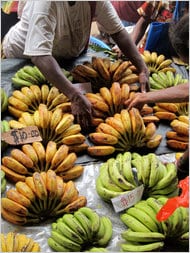
The capital city of the Solomon Islands, Honiara, really ticks to a different clock. For all its hustle and bustle, rattling trucks, scampering feet, laughter and clamor, Honiara is on Solomon time. As hard as you may try to keep a tight schedule, time in the Solomons tends to open up and swallow itself.
Today has been a long day. Nonstop walking, driving, running and sweating, and as on most days here in Honiara, I had a hopeful list of tasks that’s not even half done. And all the while I’m surrounded by people whose lists are not measured in hours or days, but in Solomon time, time that ticks to conversations, chance meetings and the steady beat of bare feet across the many juxtaposed lives and cultures that mingle here.
In Honiara, as in many capital cities in this part of the world, rapid growth, lots of old and ailing vehicles belching out smoke, limited fresh water and poor waste disposal all assault one’s respiratory and digestive systems. So a roiling gut presents another real challenge to my day. A wise old woman has me rubbing pure coconut oil infused with some aromatic herb up my nose to keep the dust and grit from getting too far into my head. The nut grease seems to be working, though it makes the whole world smell like a citrus coconut cream pie.
Days here are also complicated by something of a double life.

My long-term research is combined with a growing role in developing and supporting community-driven forest and marine conservation work. The vast untrammeled mosaics of tall forest, shifting garden sites and gin-clear freestone streams I encountered when I first came to the Solomons are gone across huge swaths of the islands. Growing demand for raw tropical hardwood logs in Asia and little regulatory capacity here has placed immense pressures on local subsistence communities that are home to more than 80 percent of Solomon Islanders.
In time, forests will recover to a degree, but human communities housed and nourished within them since beyond living memory are now fighting over firewood and thirsty for clean water. In the face of this trend, from a biologist’s perspective, the choice was to either resign myself to writing epitaphs for a vanishing world or combine research with active conservation practice. The choice was not a hard one to make.
Day to day, combining conservation work here with my research means that in between purchasing bush knives (machetes) and new topographic maps (the originals, made in the 1960s, were 1 degree latitude off, which means a lot when humping around deep bush rippling with cliffs of up to 600 meters), and finding rebar for marking transects and forest plots, I have to meet with government ministers, check in with authorities about shady timber licensing deals, and track down key customary landholders who are scattered about every nook and cranny of this growing island capital.
Land in Solomons is not really owned – “landowner” is a word that doesn’t exist in most of the more than 80 endemic languages spoken here; several as distinct as English and Greek are murmured within my earshot now. Yet every indigenous Solomon Islander has rights and entitlement to land and marine areas passed from generation to generation through word of mouth, illustrated by actions or symbols, for all members of a lineage, tribe or clan. Today, individuals in local communities control nearly 90 percent of land area in Solomons. So everybody you pass on the dusty, bustling streets is a king or queen of sorts, with rights and entitlement to pieces of some of the last great island wilderness left on earth. Recognizing this, cherishing it, lies at the heart of the approach we are taking to improve forest management. The work of a Solomon Islands conservationist is truly in the streets.
So my day is peppered with chance (and not so chance) meetings on buses, along the docks, in shops that have the best bush knives, and often in the Honiara Central Market. All this with my trusty list in hand, rewritten with each twist and turn through the heavy heat of the day.
One thing on my list that never gets scratched (item No. 7 of 27 today) is “eat ripe green bananas,” which I am doing right now. I am also eating little fat pale yellow ones and giant monster sausage-shaped bananas, all with tastes and textures of their own. The Solomon Islands is one of the birthplaces of bananas – plants that grow only by human hands, for they have been bred to lack the ragged, rock-hard seeds of their wild ancestry – and there are more kinds of bananas here than there are types of breakfast cereal in an American supermarket. It is luscious nourishment, settling my belly before the journey west to the many volcanoes of the New Georgia Islands, with Kolombangara, mist-enshrouded, towering above all the rest.
